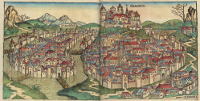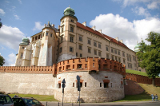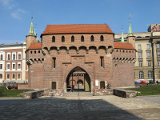About Cracow
The town of Cracow: History
 Cracow was noted as an important town in the middle of the 10th
century, becoming a royal residence by the 11th century. Burned down
completely by Tartars in 1241 (except for a very few churches) it was
rebuilt in 1251 with its regular network of streets and squares, preserved
until now as an example of medieval city design. Since 1320, it was the
official site of the coronation of Polish kings and the place of their burial.
In this role, Cracow continued even when the royal residence had been moved to
Warsaw by the end of the 16th century. Since 1364, Cracow has been the site of
one of oldest universities in Europe - the Jagiellonian University. It
was also in the 14th century that the King Casimir the Great
established a twin town (called
Kazimierz after his name) on the
opposite bank of the Vistula (Fig.), which later became a picturesque Jewish town,
unique in its character and tradition.
Cracow was noted as an important town in the middle of the 10th
century, becoming a royal residence by the 11th century. Burned down
completely by Tartars in 1241 (except for a very few churches) it was
rebuilt in 1251 with its regular network of streets and squares, preserved
until now as an example of medieval city design. Since 1320, it was the
official site of the coronation of Polish kings and the place of their burial.
In this role, Cracow continued even when the royal residence had been moved to
Warsaw by the end of the 16th century. Since 1364, Cracow has been the site of
one of oldest universities in Europe - the Jagiellonian University. It
was also in the 14th century that the King Casimir the Great
established a twin town (called
Kazimierz after his name) on the
opposite bank of the Vistula (Fig.), which later became a picturesque Jewish town,
unique in its character and tradition.
At the end of the 18th century Cracow fell under Austrian rule. Nevertheless, since the second half of 19th century Cracow and the southern part of Poland enjoyed relative freedom. The Jagiellonian University could work with Polish as its official language. While Poland was politically non-existent, Cracow became the real centre of Polish art, culture, and literature. After World War I, it was the first major town and the first part of restored Poland, liberated by Polish soldiers who refused service in the Imperial army. In the years of Nazi occupation (1939–1945) Cracow was the residence of the General Governor Frank, whose summer palace is now the site of our Conference. Under the communist rule, science, literature, and culture in Cracow suffered from the same limitations as everywhere in East Europe, regaining full freedom after 1989.
The monuments of Cracow
 The Old Town of Cracow is an UNESCO protected monument. The first place
recommended for visit is the Wawel (Fig.) with a
whole complex of buildings forming the Royal residence. Its Gothic
(14th century) Royal Cathedral houses the tombs of almost all Polish
kings after 1333. Their graves are partly located in the Cathedral crypt, where
you can see well-preserved parts of an earlier, Romanesque church from the late
11th/early 12th centuries.
The Old Town of Cracow is an UNESCO protected monument. The first place
recommended for visit is the Wawel (Fig.) with a
whole complex of buildings forming the Royal residence. Its Gothic
(14th century) Royal Cathedral houses the tombs of almost all Polish
kings after 1333. Their graves are partly located in the Cathedral crypt, where
you can see well-preserved parts of an earlier, Romanesque church from the late
11th/early 12th centuries.
A special exhibition "The lost Wawel" shows one of the oldest churches in Poland constructed there probably at the end of the 10th century, and you can enjoy a computer animation showing the development of the Wawel from earliest documented times (the 9–10th century) to its present shape. Worth visiting are the collection of arms and the Royal Treasury arranged in preserved parts of the Gothic castle, as well as the royal chambers with a collection of renaissance furniture and tapestries in the interior of the 16th century royal palace.
 From the Wawel, we recommend that you walk towards the centre along Kanonicza
street, enjoying a whole line of picturesque late-gothic and renaissance
houses. On the way, you can see the best preserved Romanesque
(11/12th century) building St. Andreas
Church,
then also early-gothic St. Francis and St. Dominic churches built in the
13th century. Making a small detour you can visit Collegium
Maius (Fig.) - the oldest (early
15th century) University building now housing the Museum of Science.
From the Wawel, we recommend that you walk towards the centre along Kanonicza
street, enjoying a whole line of picturesque late-gothic and renaissance
houses. On the way, you can see the best preserved Romanesque
(11/12th century) building St. Andreas
Church,
then also early-gothic St. Francis and St. Dominic churches built in the
13th century. Making a small detour you can visit Collegium
Maius (Fig.) - the oldest (early
15th century) University building now housing the Museum of Science.
 Reaching the Main Square you can pass near another very old Romanesque Church,
St. Adalberts, to stop
briefly at the Holy Virgin
Basilica, the
14th century "pearl of Polish Gothic art". Inside it, there is a
famous altar (Fig.), sculptured
at the end of 15th century by Wit Stwosz (Weit Stoss), the Great
Master from Nürnberg who lived and worked in Cracow.
Reaching the Main Square you can pass near another very old Romanesque Church,
St. Adalberts, to stop
briefly at the Holy Virgin
Basilica, the
14th century "pearl of Polish Gothic art". Inside it, there is a
famous altar (Fig.), sculptured
at the end of 15th century by Wit Stwosz (Weit Stoss), the Great
Master from Nürnberg who lived and worked in Cracow.
 Continuing westward along Florianska Street, you can visit the picturesque
relics of the 13/14th City Walls with three well-preserved medieval
towers and an unique barbican (Fig.), one of few such constructions preserved
in Europe. In Kazimierz, worth visiting is the Old
Synagogue
(16th) century, now housing the Museum of Jewish Culture and
Tradition.
Continuing westward along Florianska Street, you can visit the picturesque
relics of the 13/14th City Walls with three well-preserved medieval
towers and an unique barbican (Fig.), one of few such constructions preserved
in Europe. In Kazimierz, worth visiting is the Old
Synagogue
(16th) century, now housing the Museum of Jewish Culture and
Tradition.
Links
Other interesting sites
Contemporary Cracow
Cracow is now the site of several universities. In addition to the Jagiellonian University there are: the AGH University of Science and Technology, the University of Technology, the Agricultural University, the Academy of Fine Arts, the Pedagogical University, and the University of Economics. Cracow also retains its world position in culture: in 2000 was the European Capital of Culture having several world famous theatres: Teatr Slowackiego and Teatr Stary (mostly classical repertoire), the Opera, and Teatr Groteska. Worth visiting are the Museums: the National Gallery in Sukiennice (the Main Square), the Szolayski Museum (old medieval arts), the Czartoryski Collection and many others.
 Tired with centuries of history you can enjoy the shopping in the Main Square (Fig.), visiting
numerous shops with antiquities and jewellery, book stores and music shops. Inside the
medieval cloth-market (Sukiennice) there is a whole line of small shops with thousands of
traditionally-styled souvenirs. Then, you can enjoy the evening life of Cracow in numerous
cafes and restaurants clustered around the Main Square as well as along adjacent
historical streets. You can make a choice: in many of them you can listen to live music
from modern to traditional jazz. Don't forget to visit the district of the Old Synagogue
in Kazimierz, where numerous Jewish-styled cafes are now revived, together with
traditional Klezmer music ensembles.
Tired with centuries of history you can enjoy the shopping in the Main Square (Fig.), visiting
numerous shops with antiquities and jewellery, book stores and music shops. Inside the
medieval cloth-market (Sukiennice) there is a whole line of small shops with thousands of
traditionally-styled souvenirs. Then, you can enjoy the evening life of Cracow in numerous
cafes and restaurants clustered around the Main Square as well as along adjacent
historical streets. You can make a choice: in many of them you can listen to live music
from modern to traditional jazz. Don't forget to visit the district of the Old Synagogue
in Kazimierz, where numerous Jewish-styled cafes are now revived, together with
traditional Klezmer music ensembles.
The Jagiellonian University and its traditions
 The Jagiellonian University (Fig.) is one of the oldest in Europe. It was
founded in 1364 by King Casimir the Great, who performed great reforms in
Poland: a popular proverb says that "He found Poland made of wood and left it
made of bricks". In fact his reign was a period of a great political and
economic consolidation after two dark centuries of internal divisions and
dynastic wars. Most of the towns gained solid city walls, and Gothic churches
and castles were built across the country. One of the important tasks was the
consolidation and unification of regional and traditional laws: one major aim
of the University was to educate the body of lawyers needed for this important
task.
The Jagiellonian University (Fig.) is one of the oldest in Europe. It was
founded in 1364 by King Casimir the Great, who performed great reforms in
Poland: a popular proverb says that "He found Poland made of wood and left it
made of bricks". In fact his reign was a period of a great political and
economic consolidation after two dark centuries of internal divisions and
dynastic wars. Most of the towns gained solid city walls, and Gothic churches
and castles were built across the country. One of the important tasks was the
consolidation and unification of regional and traditional laws: one major aim
of the University was to educate the body of lawyers needed for this important
task.
 After the premature death of the king in 1370, the University went into a
period of stagnation and degradation until about 1400. Then Queen Jadwiga dying
young after the birth of a daughter made a large donation for the restoration
of the University, which then entered its golden era. In the 15th
century the Jagiellonian University joined the small group of Universities
worldwide in which mathematics and astronomy were the leading faculties. By the
end of that century, the University had a famous student: Nicolas Copernicus
(Fig.). In the 19th century, when Poland was occupied by
neighbouring Empires, the University of Cracow was lucky to continue these
traditions retaining the Polish language and being a centre for Polish science
and culture.
After the premature death of the king in 1370, the University went into a
period of stagnation and degradation until about 1400. Then Queen Jadwiga dying
young after the birth of a daughter made a large donation for the restoration
of the University, which then entered its golden era. In the 15th
century the Jagiellonian University joined the small group of Universities
worldwide in which mathematics and astronomy were the leading faculties. By the
end of that century, the University had a famous student: Nicolas Copernicus
(Fig.). In the 19th century, when Poland was occupied by
neighbouring Empires, the University of Cracow was lucky to continue these
traditions retaining the Polish language and being a centre for Polish science
and culture.